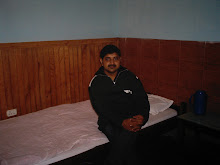
The Durga Pujas are here. For Bengalees all over the world this is a great moment. Wait, it won’t be proper to call a five day festival a moment. Let’s call it an extended metaphor of life in its best form. Apparently people forget all their sorrows, tensions and problems of life during these days and plunge into this massive celebration of the life’s vitality. Here’s wishing you all a very happy sharadiya. I hope you would excuse me for wishing you all a happy Durga Puja on Nabami, when in fact, it’s almost over. Nevertheless, it is never too late for a wish.
Well, what exactly is this celebration of life’s vitality? The simple answer is: ask a Bengali. And the difficult answer is: see it yourselves. For the best first hand experience you have to be at Kolkata during this time but for a less complicated version any Bengali community in the world would do. Whether they say hello to each other throughout the year doesn’t really matter but they must get together for a Durga Puja. It’s a marvelous teamwork—the Durga Puja. At Kolkata and at most other places in Bengal the clubs plunge for the pujas well in advance, set up their exorbitant budgets and chalk out plans for the final deluge. If it is artistic, big-budgeted and marketed enough, deluge of all kinds follow (cash and kind—in the form of crowds). The city changes overnight. Bright and dazzling lights (strung, hung, mounted and even floated) obliterate all memories of recent power cuts. Police personnel and volunteers patrol at every significant crossing and the roads are flooded with people—pandal hoppers who incessantly pour into the puja pandals north to south, east to west. Everyone is dressed up at his/her best and (believe me it’s a wonder) the next door common girl looks suddenly gorgeous in her ashtami saree. During no other time or festival do so many people together enjoy a common holiday. Yet three kinds of people spend their busiest time during the Pujas. They are the police, the cooks and waiters at the restaurants and the media personnel. Well, during the Pujas people must take the roads in a jubilant (!) and festive mood, hence the police; once they’ve hit the streets, they’ll sooner or later feel hungry, hence the food people; and all this activity must projected live since people are TRP, hence the media.
This is the festive spirit in a nutshell. Well, the mention of media reminds me of something. Yet again it’s a wonder how during the Pujas the media tends to voluntarily forget what they love most—political complications. Instead they send all their correspondents to cover the Pujas. The senior and apparently ‘good’ journalists get at best flight tickets to cover international Durga Pujas and at worst Pujas in Mumbai or Delhi while the trainees and less fortunate ones have to travel to the god–forbidden districts of West Bengal. For a change the Breaking News is that the streets are being flooded with people or Sourav Ganguly just paid a visit to the local Puja pandal. Locals are worshipped everywhere and the Durga Puja gives us an opportunity to see our celebrities being party to what we enjoy as well and thereby derive a subversive pleasure. Its like seeing the party you’ve voted for, win.
But the question remains as to how sincere is this representation of joy? Does everyone ‘enjoy’ the apparent ‘facelift’ of the city? What about ‘other’ voices? In this incessant game of visual projection that often becomes an assault on our senses, is everyone invited, as they do it in Samsung? What about big-budget pujas in dingy alleys? While in the queue to the pandal have we turned our eyes to the shut windows of the nearby house? Inside it inhabitants may be waiting for all of it to be over so that their ground floor windows could be reopened. Or worse still, what about those houses that lie behind the acute artistic carvings on cloth covers en route the pandal. The poor souls have been denied their tiny share of fresh air and sunlight for these days. Add to it the nuisance of the mike. Huge woofers, boxes and digital technology collaborate to multiply the volume of music that accompanies the Puja for all five days. For strategic locations where sound waves of several Pujas meet, it’s a real free for all to an extent that you are unable to hear the person standing next to you. Before all this has gone the ‘chanda’ phase, where you are expected to donate heavy sums for the fund-raising ‘efforts’ of the organizers. The more the fund, the better the arrangements, the cleverer the theme and hence greater the chance of winning prizes. On the pretext of religiosity it’s a primordial battle for the first position.
Well, doesn’t really mean that I don’t enjoy the Durga Puja and this huge human deluge. But when would we spare a thought for those who don’t?
(Also check out Ushasi’s article in anandabazar patrika today, which is, incidentally on similar lines)

